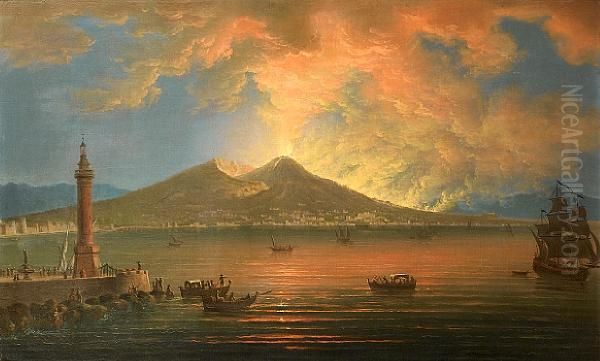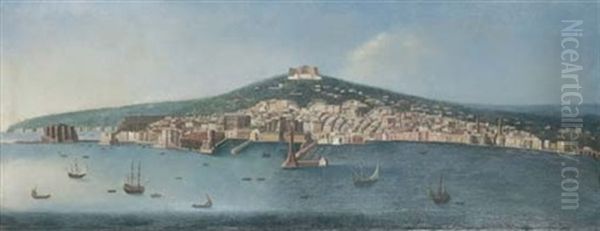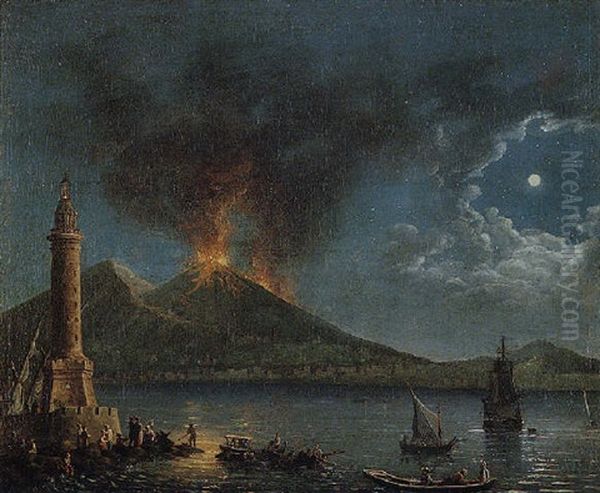Pietro Antoniani, an Italian painter active predominantly in the latter half of the 18th century, carved a notable niche for himself through his evocative landscapes, dramatic depictions of volcanic eruptions, and detailed architectural views. Born in 1740 and passing away in 1805, Antoniani's career unfolded during a period of significant artistic and cultural transition, witnessing the flourishing of the Grand Tour, the unearthing of ancient cities, and the enduring appeal of the Italian landscape to both local patrons and international visitors. His works, particularly those centered around Naples and the formidable Mount Vesuvius, capture the spirit of an era fascinated by both the beauty and the terrifying power of nature.
The Artistic Milieu of 18th-Century Italy
To understand Pietro Antoniani's contributions, one must first appreciate the vibrant artistic environment of 18th-century Italy. The peninsula, though politically fragmented, remained a cultural epicenter, drawing artists, scholars, and aristocrats from across Europe. The tradition of the Grand Tour, a journey undertaken by young noblemen and aspiring intellectuals to complete their education, brought a constant stream of wealthy foreigners eager for mementos of their travels. This demand fueled a thriving market for paintings, particularly "vedute" (view paintings) that captured the famous sights of cities like Rome, Venice, and Naples.
Artists such as Giovanni Paolo Panini in Rome specialized in depicting ancient ruins and contemporary cityscapes, often imbuing them with a sense of grandeur and historical weight. In Venice, Canaletto (Giovanni Antonio Canal) and his nephew Bernardo Bellotto, along with Francesco Guardi, brought veduta painting to unparalleled heights of precision and atmospheric effect. Their detailed portrayals of Venetian canals, festivals, and architecture were highly sought after. This broader context of view painting undoubtedly influenced artists like Antoniani, who adapted these traditions to his chosen locales.

Naples, where Antoniani was particularly active, held a unique allure. It was a bustling metropolis, the capital of a kingdom, and, most dramatically, lay in the shadow of Mount Vesuvius. The recent discoveries of Herculaneum (excavations began systematically in 1738) and Pompeii (1748) further ignited interest in the region, linking its present vibrancy to a dramatic, buried past. This potent combination of natural beauty, ancient history, and the ever-present threat of volcanic activity provided rich subject matter for artists.
Antoniani's Life and Career Trajectory
While specific details about Pietro Antoniani's early training remain somewhat scarce in easily accessible records, his active period from roughly the 1760s to the early 1800s places him firmly within this dynamic artistic landscape. His Italian nationality is well-established, and his professional activities centered significantly around Milan and, more prominently, Naples. It is in Naples that his most characteristic works, particularly those depicting volcanic phenomena, were likely conceived and executed.
The period of his activity, 1740-1805, means he was a contemporary of many leading figures in European art. For instance, the French landscape and marine painter Claude Joseph Vernet spent a significant portion of his career in Italy, including Naples, and was renowned for his dramatic seascapes, storms, and, occasionally, depictions of Vesuvius. It is highly probable that Antoniani would have been aware of Vernet's work, which was widely acclaimed. Similarly, the Welsh painter Richard Wilson, often called the "father of British landscape painting," spent several years in Italy (1750-1757) and was influenced by the Italian landscape tradition, particularly the works of Claude Lorrain and Gaspard Dughet. Wilson's approach to landscape, blending classical ideals with natural observation, was part of the broader European artistic dialogue Antoniani participated in.
Antoniani's association with the House of Savoy suggests patronage from influential circles. The House of Savoy, with its primary seat in Turin (Piedmont), was a significant power in Italy. Commissions for decorative schemes in royal residences would have provided artists with prestige and financial stability. This indicates that Antoniani's talents were recognized and valued by the aristocracy, who often favored landscapes and architectural views to adorn their palaces.
The Allure of Vesuvius: Capturing the Sublime
Pietro Antoniani is perhaps best known for his dramatic and often terrifying depictions of Mount Vesuvius erupting. These paintings tap into the 18th-century aesthetic concept of the "Sublime," which found beauty and awe in experiences that could also inspire terror, vastness, and overwhelming power. Volcanic eruptions, with their fiery displays, plumes of smoke, and destructive potential, were prime subjects for artists exploring the Sublime.

His work, such as the often-cited "Eruption of Vesuvius," would have shown the volcano in full fury, likely at night to accentuate the glowing lava and the fiery spectacle against a dark sky. Such scenes often included small figures of onlookers in the foreground, their diminutive scale emphasizing the immense power of nature. These figures served not only to provide a sense of scale but also to guide the viewer's emotional response – a mixture of fear, wonder, and scientific curiosity.
The market for Vesuvius paintings was robust. Grand Tourists were particularly keen to acquire such images as dramatic souvenirs of their visit to Naples. Antoniani was not alone in catering to this demand. The German painter Jacob Philipp Hackert, who also worked extensively in Naples and was a favorite of King Ferdinand IV, produced numerous views of Vesuvius and the surrounding Bay of Naples. Another notable figure was Pierre-Jacques Volaire, a French painter who specialized almost exclusively in depicting Vesuvius's eruptions with dramatic flair and a keen eye for pyrotechnic detail. Antoniani's works would have been part of this popular genre, each artist bringing their own nuances to the subject.
The style employed in these volcanic scenes often combined a degree of topographical accuracy with heightened drama. The play of light and shadow (chiaroscuro) would be crucial, with the incandescent lava providing the primary light source, casting an eerie glow on the landscape, the Bay of Naples, and the terrified or awestruck spectators. The depiction of smoke, ash, and molten rock required considerable skill to convey both the texture and the chaotic energy of the event.
Landscapes and Vedute: Beyond the Volcano
While volcanic eruptions were a significant theme, Antoniani's oeuvre also encompassed broader landscape and architectural views. His painting "Napoli del molo" (View of the Port of Naples), dated to the period 1771-1776, exemplifies his skill in veduta painting. Such works would have meticulously detailed the bustling activity of the port, the ships, the architecture along the waterfront, and often, Vesuvius looming in the background, a constant reminder of its presence even in quiescence. These views catered to the desire for accurate and picturesque representations of famous locations.

His "Landscape of Paestum" or "Paestum with Visitors" is another important example of his work, reflecting the burgeoning interest in recently rediscovered archaeological sites. Paestum, with its remarkably well-preserved Greek temples, became a key stop on the Grand Tour after its "rediscovery" in the mid-18th century. Artists like Giovanni Battista Piranesi, though more famous for his Roman views and imaginative "Carceri d'Invenzione" (Imaginary Prisons), also produced etchings of Paestum that emphasized their majestic desolation and ancient grandeur. Antoniani's depiction of Paestum would likely have shown tourists exploring the ruins, highlighting the contemporary fascination with antiquity. This theme aligns with the rise of Neoclassicism, an artistic movement that drew inspiration from the art and culture of ancient Greece and Rome.
The style of these landscapes would have been influenced by the prevailing Italian landscape tradition, which had deep roots going back to artists like Annibale Carracci and Domenichino in the Baroque period, who developed the "ideal landscape." However, by the 18th century, there was also a strong current of naturalism, particularly in veduta painting. Antoniani's work seems to blend a faithful representation of place with a pleasing composition and often a subtle narrative element, such as the inclusion of figures engaged in daily activities or tourism. His handling of light and atmosphere would have been crucial in conveying the specific character of the Italian scenery.
Artistic Style, Technique, and Influences
Pietro Antoniani's style can be characterized by a commitment to detailed observation, particularly in his architectural and topographical subjects. His works demonstrate a fine brushwork and a keen understanding of perspective, essential for convincing vedute. The influence of the Italian landscape school is evident in his compositions, which often balance natural elements with human presence and architectural features.
In his volcanic scenes, a more dramatic and emotional quality emerges. Here, the influence of painters like Salvator Rosa, a 17th-century artist known for his wild, rugged landscapes, stormy seas, and scenes of witchcraft or banditry, might be discerned. Rosa's work prefigured the Romantic fascination with the untamed aspects of nature and the Sublime. While Antoniani's work is generally more controlled and less overtly "romantic" than Rosa's, the dramatic subject matter of Vesuvius allowed for a similar exploration of nature's awesome power.
The reference to a "Rococo" influence in some descriptions of his work suggests an attention to decorative qualities, perhaps a lighter palette in some landscapes, and graceful compositions, particularly if his works were intended for specific interior decorations, such as those for the House of Savoy. Rococo, with its emphasis on elegance, asymmetry, and themes of leisure and romance, was a dominant style in the earlier part of the 18th century, and its influence lingered.
Conversely, his depictions of classical ruins like Paestum align with the emerging Neoclassical sensibility. Neoclassicism favored order, clarity, and themes from antiquity, reacting against the perceived frivolity of Rococo. Artists like Anton Raphael Mengs, a German painter who was a leading proponent of Neoclassicism in Rome, championed a return to classical ideals. Antoniani's engagement with archaeological subjects places him within this broader cultural shift.
His technique likely involved careful preliminary sketches, especially for detailed vedute. The use of a camera obscura, a device used by many veduta painters including Canaletto to achieve high levels of accuracy in perspective and detail, cannot be ruled out, though direct evidence for Antoniani's use of it may be lacking. His color palette would have varied according to the subject: vibrant and fiery for eruptions, more naturalistic and sun-drenched for daytime landscapes, and perhaps more somber and evocative for scenes of ancient ruins.
Collaborations, Contemporaries, and Market Standing
The art world of the 18th century was often collaborative, though specific records of Antoniani's direct collaborations with other named painters are not prominent in the provided information. However, artists often worked in studios, employed assistants, or were part of networks that facilitated commissions and sales. His work for Sir Edward Walter, an English collector, in acquiring landscape paintings suggests he may have acted as an agent or advisor, a role not uncommon for established artists.
His paintings were sold in a competitive market. As mentioned, Naples was a hub for artists catering to the Grand Tour market. Besides Volaire and Hackert, other artists like Antonio Joli, who worked in Naples, Venice, London, and Madrid, produced vedute and capricci (architectural fantasies). Antoniani's works would have been viewed alongside theirs. The estimated auction values for his paintings in modern times—such as £50,000-£70,000 for an "Eruption of Vesuvius" and £10,000-£18,000 for the "Paestum" scene—indicate a continued appreciation for his skill and the historical significance of his subjects. These prices place him as a competent and respected master of his genre, though perhaps not in the absolute top tier of market value occupied by figures like Canaletto.
It is also important to note the potential for confusion with other artists named Antoniani. The provided text mentions a Francesco Antoniani, also an Italian artist active in a similar period (late 17th to early 18th century, or perhaps overlapping with Pietro) and also known for landscapes and architectural works. Distinguishing between artists with similar names and specializations from centuries past can be a challenge for art historians without definitive provenance or signed works. However, the body of work attributed to Pietro Antoniani, particularly his Vesuvius scenes and Neapolitan vedute from the 1740-1805 period, forms a coherent group.
Legacy and Historical Evaluation
Pietro Antoniani's legacy lies in his contribution to 18th-century Italian landscape painting and his vivid documentation of one of Europe's most dramatic natural phenomena. His depictions of Vesuvius are valuable not only as works of art but also as historical records of volcanic activity and contemporary reactions to it. They capture the Enlightenment's dual fascination with nature: a subject of scientific inquiry and a source of profound aesthetic and emotional experience.
His vedute of Naples and Paestum contribute to the rich tradition of Italian view painting, offering glimpses into the appearance and life of these locations during a pivotal period of cultural exchange and discovery. The patronage he received from the House of Savoy further attests to his standing during his lifetime.
While he may not be as universally recognized as some of his Venetian contemporaries like Canaletto or Guardi, or as revolutionary as figures who dramatically shifted art history's course, Pietro Antoniani remains an important figure within his specific domain. His paintings are appreciated for their technical skill, their engaging subject matter, and their embodiment of 18th-century tastes and interests. His work is represented in various collections, and its appearance at auction continues to attract interest from collectors of European Old Master paintings, particularly those specializing in Italian views or depictions of the Grand Tour.
In the broader narrative of art history, Antoniani exemplifies the skilled professional artist who successfully navigated the demands of patrons and the market, producing works that were both popular in their time and retain their appeal and historical value today. He was a product of his time, responding to its intellectual currents—the rise of scientific inquiry, the Neoclassical revival, the aesthetic of the Sublime—and translating them into compelling visual statements. His paintings invite us to explore the landscapes of 18th-century Italy, to witness the awesome power of Vesuvius, and to appreciate the enduring human fascination with the interplay of nature, history, and art. His contribution, while specific, enriches our understanding of a vibrant chapter in European art.